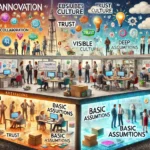If an organization has had a fixed culture for a long time, changing it can feel like one of the hardest tasks in the world! But the reality is that no culture stays the same forever. The business landscape is constantly evolving—new generations enter the workforce, technology reshapes everything, and companies that fail to adapt simply fall behind.
That leads to an important question:
How can you change an organization’s culture without creating confusion or resistance among teams?
Changing culture is like altering an organization’s DNA. It’s not easy, but it’s definitely possible! In this post, I’ll share key strategies for successfully shifting organizational culture.
Why Does Organizational Culture Need to Change?
🔹 Sometimes, a company realizes its existing culture no longer works.
🔹 A crisis might force the company to make immediate cultural shifts.
🔹 Market changes, technological advancements, and evolving employee expectations often drive the need for cultural transformation.
Real-life examples:
💡 Microsoft: Before Satya Nadella became CEO, Microsoft had a rigid, competitive culture that stifled innovation. Nadella transformed it into a culture of “growth mindset” and collaboration.
💡 Netflix: As the market evolved, Netflix abandoned the traditional corporate media culture and built an agile, data-driven, and flexible work environment.
So how do these transformations actually happen?
Steps to Changing Organizational Culture
1. Assess the Current Culture – You Can’t Change What You Don’t Understand!
🔹 The first step is to evaluate where the organization currently stands.
🔹 Identify what’s working well and what needs to change.
✅ How to do this?
- Conduct employee surveys on company culture.
- Interview managers and team members.
- Analyze HR data, such as turnover rates and employee satisfaction.
🔹 Example: A tech company struggling with innovation discovered that employees feared making mistakes because failures were punished. The first step in transforming the culture was eliminating this fear of failure.
2. Define the New Culture – Have a Clear Vision for the Future!
🔹 A new culture shouldn’t just be a slogan—it needs to be crystal clear in terms of how employees should behave, how decisions should be made, and what changes need to occur.
✅ How to do this?
- Define the new core values.
- Create a clear statement on expected behaviors.
- Set transparent goals for cultural change.
🔹 Example: When Nadella joined Microsoft, he said: “We need to shift from a ‘know-it-all’ culture to a ‘learn-it-all’ culture.” This clear message directly influenced employee behaviors.
3. Strong Leadership – Change Starts at the Top!
🔹 If company leaders don’t change, nothing else will.
🔹 Managers must embody the new culture through their own actions.
✅ How to do this?
- Train and guide managers through the change process.
- Ensure transparency in decision-making and new behaviors.
- Leaders must act as role models.
🔹 Example: Under Uber’s former CEO Travis Kalanick, a cutthroat and sometimes toxic culture emerged. When Dara Khosrowshahi took over, he repositioned himself as an ethical and people-focused leader, gradually reshaping the company’s culture.
4. Change the Reward System – People Will Behave How They Are Rewarded!
🔹 You can drive cultural change by rewarding new behaviors and discontinuing incentives for old ones.
✅ How to do this?
- Adjust performance evaluation systems to reflect new values.
- Reward employees who exhibit the desired behaviors.
- Eliminate systems that reinforce undesirable behavior.
🔹 Example: If a company wants to foster collaboration instead of internal competition, it shouldn’t only reward high-performing individuals but should also recognize teams that work well together.
5. Create New Stories, Symbols, and Rituals
🔹 Culture change sticks when it becomes part of everyday life through stories and symbols.
✅ How to do this?
- Share success stories of employees who exemplify the new culture.
- Change company symbols (e.g., office design, meeting styles).
- Organize events that reinforce the new values.
🔹 Example: 💡 Netflix: To promote its “trust and accountability” culture, Netflix introduced unlimited vacation time—this symbolic move reinforced employee autonomy.
6. Monitor and Adjust – Change Is an Ongoing Process, Not a One-Time Project!
🔹 Cultural transformation takes time and must be regularly evaluated.
✅ How to do this?
- Conduct ongoing employee surveys to track the impact of changes.
- Hold feedback sessions with employees.
- Adjust strategies as needed.
🔹 Example: 💡 Microsoft: After initial culture changes, Nadella monitored feedback and noticed that some managers still followed outdated leadership styles. He then focused on additional leadership training.
Challenges in Changing Organizational Culture
🔹 Employee Resistance: People naturally resist change, especially when they don’t understand why it’s necessary.
🔹 The Process Takes Time: Cultural shifts don’t happen overnight—they require patience and persistence.
🔹 Inconsistency Across Departments: If one part of the company changes but others stick to old habits, the transformation won’t be successful.
Culture Change Means Changing Daily Behaviors!
✔ Culture shifts when real employee behaviors change—not just when leadership talks about it in PowerPoint presentations.
✔ Strong leadership, the right reward systems, and clear communication are key to successful cultural change.
✔ Every cultural transformation must be continuously monitored and adjusted along the way.
Now It’s Your Turn!
Have you ever worked at a company trying to change its culture? Was it a success or a failure? Let’s discuss! 😊












